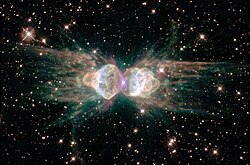Ameisennebel
| Planetarischer Nebel Daten des Ameisennebels / von Mz 3 | |
|---|---|
 | |
| Der Ameisennebel, aufgenommen vom Hubble-Weltraumteleskop | |
| AladinLite | |
| Sternbild | Winkelmaß |
| Position Äquinoktium: J2000.0 | |
| Rektaszension | 16h 17m 13,4s |
| Deklination | −51° 59′ 10,3″ |
| Erscheinungsbild | |
| Scheinbare Helligkeit (visuell) | 13,8 mag |
| Winkelausdehnung | 2,5′ × 0,5′ |
| Zentralstern | |
| Scheinbare Helligkeit | 14 mag |
| Spektralklasse | O9 |
| Physikalische Daten | |
| Radialgeschwindigkeit | −21,2 km/s |
| Entfernung | 8920 ± 2210 Lj |
| Durchmesser | 2 Lichtjahre |
| Geschichte | |
| Entdeckung | Donald Menzel |
| Datum der Entdeckung | 1922 |
| Katalogbezeichnungen | |
| PK 331-01 1 • ESO 225-PN9 • Mz 3 • Hen 2-154 • RCW 101 | |
Der Ameisennebel ist ein junger planetarischer Nebel. Andere Namen für den Ameisennebel sind Menzel 3 (Abk.: Mz 3). Der Name Ameisennebel kommt von seinem Aussehen, da er dem Thorax einer Ameise ähnelt.
Er entstand dadurch, dass abgestoßenes Material des zentralen Roten Riesen auf Gase seines Begleiters traf, welcher ein Weißer Zwerg ist.[1]
Der Ameisennebel breitet sich strahlenförmig mit einer Geschwindigkeit von ca. 50 km/s aus. Oftmals wird er aufgrund der ähnlichen Entstehungsgeschichte mit dem Schmetterlingsnebel verglichen. Er zeigt keine Spur von molekularen Wasserstoff-Ausstößen.
Der Ameisennebel wurde 1922 von Donald Menzel auf Fotografien des 24-Zoll-Bruce-Teleskops an der Außenstation des Harvard College Observatory in Arequipa in Peru entdeckt.[2][3]
Literatur
- König, Michael & Binnewies, Stefan (2023): Bildatlas der Sternhaufen & Nebel, Stuttgart: Kosmos, S. 216
Weblinks
Einzelnachweise
- ↑ Scott, Carole., United States. National Aeronautics and Space Administration.: Space - das Weltall : eine einzigartige Reise durchs Universum : [mit neuen Bildern der NASA]. Dorling Kindersley, München 2011, ISBN 978-3-8310-1972-4.
- ↑ D. N. Menzel: Five new planetary nebulae., bibcode:1922BHarO.777....0M
- ↑ Harlow Shapley: Five new planetary Nebulae, bibcode:1922BHarO.777R...3S
Auf dieser Seite verwendete Medien
The Ant planetary nebula (Menzel 3 or Mz 3). STScI-PRC2001-05
This NASA/ESA Hubble Space Telescope image reveals the ant's body as a pair of fiery lobes protruding from a dying, Sun-like star. Though approaching the violence of an explosion, the ejection of gas from the dying star at the center of Mz3 has intriguing symmetrical patterns unlike the chaotic patterns expected from an ordinary explosion. Scientists using the Hubble space telescope would like to understand how a spherical star can produce such prominent, non-spherical symmetries in the gas that it ejects.
One possibility is that the central star of Mz3 has a closely orbiting companion that exerts strong gravitational tidal forces, which shape the outflowing gas. For this to work, the orbiting companion star would have to be close to the dying star, about the distance of the Earth from the Sun. At that distance the orbiting companion star wouldn't be far outside the hugely bloated hulk of the dying star. It's even possible that the dying star has consumed its companion, which now orbits inside of it, much like the duck in the wolf's belly in the story "Peter and the Wolf."
A second possibility is that, as the dying star spins, its strong magnetic fields are wound up into complex shapes. Charged winds moving at speeds up to 1000 kilometers per second from the star, are able to follow the twisted field lines on their way out into space. These dense winds can be rendered visible by ultraviolet light from the hot central star or from highly supersonic collisions with the ambient gas that excites the material into florescence.
Astronomers Bruce Balick (University of Washington) and Vincent Icke (Leiden University) used Hubble to observe this planetary nebula, Mz3, in July 1997 with the Wide Field Planetary 2 camera. One year later, astronomers Raghvendra Sahai and John Trauger of the Jet Propulsion Lab in California snapped pictures of Mz3 using slightly different filters. This intriguing image, which is a composite of several filters from each of the two datasets, was created by the Hubble Heritage Team.